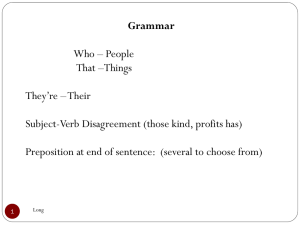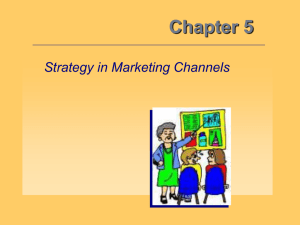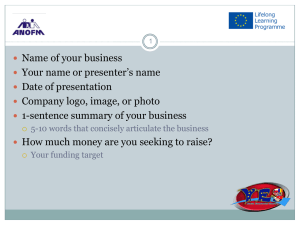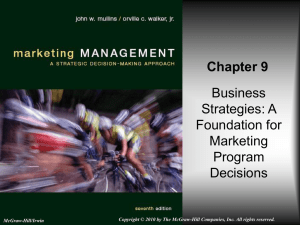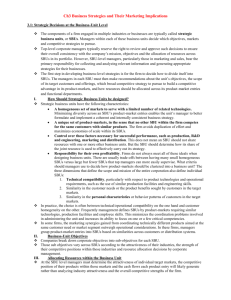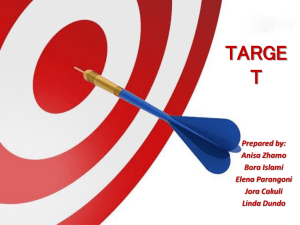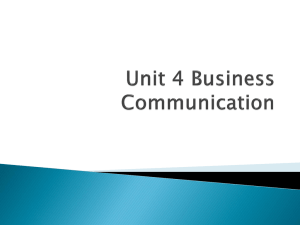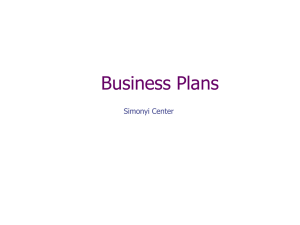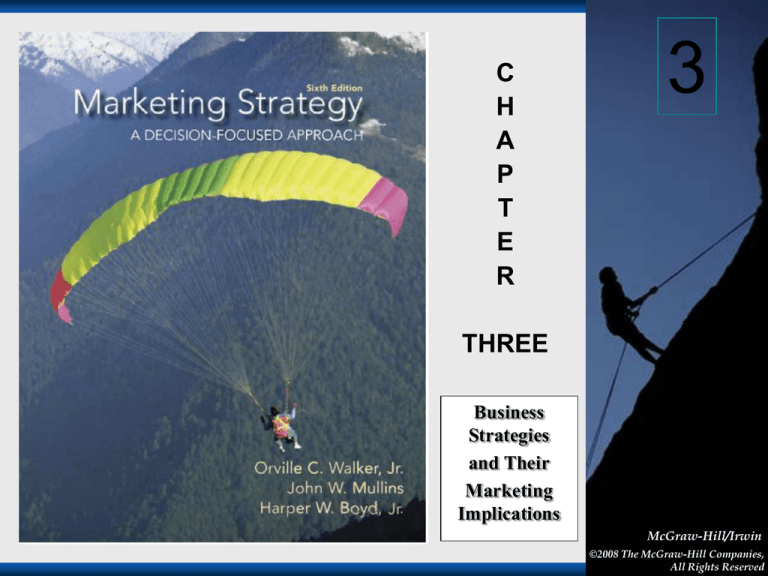
C
H
A
P
T
E
R
3
THREE
Business
Strategies
and Their
Marketing
Implications
McGraw-Hill/Irwin
©2008 The McGraw-Hill Companies,
1-1
All Rights Reserved
Ideal Characteristics of SBUs
A Homogeneous set of markets to
serve with limited number of related
technologies
A Unique set of product-markets
Control over factors necessary for
successful performance
Responsibility for their own
profitability
1-2 3-2
Dimensions That Define
Individual SBUs
Technical compatibility
Similarity in the customer needs or the
product benefits sought by customers in
the target markets.
Similarity in the personal characteristics
or behavior patterns of customers in the
target markets.
1-3 3-3
Generic Business-Level
Competitive Strategies
Michael Porter distinguishes three
strategies
Overall cost leadership
Differentiation
Focus
Robert Miles and Charles Snow classify
business units into four strategic types:
Prospectors
Defenders
Analyzers
Reactors
1-4 3-4
Definitions of Miles and Snow’s
Four Business Strategies
Prospector
Focus on growth through the development
of new products and markets.
Defender
Concentrate on maintaining positions in
established product-markets while paying
less attention to new product development.
Analyzer
Attempt to maintain a strong position in its
core product-market(s)
Seek to expand into new product-markets.
Reactors
Businesses with no clearly defined strategy.
1-5 3-5
Exhibit 3.2
Combined Typology of Business-Unit
Competitive Strategies
Emphasis on new product-market growth
Heavy emphasis
Differentiation
Cost leadership
Competitive strategy
Prospector
Units primarily
concerned with
attaining
growth through
aggressive
pursuit of new
product-market
opportunities
No emphasis
Analyzer
Defender
Units with
strong core bus.;
actively seeking
to expand into
rel. prod-mkts
with
differentiated
offerings
Units primarily
concerned with
maintaining a
differentiated
position in
mature
markets
Units with
strong core
bus.; actively
seeking to
expand into rel.
prod-mkts with
low-cost
offerings
Units primarily
concerned with
maintaining a
low-cost
position in
mature markets
Reactor
Units with no
clearly defined
productmarket
development or
competitive
strategy
1-6 3-6
Let’s combine the two perspectives and
examine the book retailing industry
Emphasis on new product-market growth
Heavy emphasis
Competitive strategy
Cost leadership Differentiation
Prospector
Units primarily
concerned with
attaining
growth through
aggressive
pursuit of new
product-market
opportunities
No emphasis
Analyzer
Defender
Units with
strong core bus.;
actively seeking
to expand into
rel. prod-mkts
with
differentiated
offerings
Units primarily
concerned with
maintaining a
differentiated
position in
mature
markets
Units with
strong core
bus.; actively
seeking to
expand into rel.
prod-mkts with
low-cost
offerings
Units primarily
concerned with
maintaining a
low-cost
position in
mature markets
Reactor
Units with no
clearly defined
productmarket
development or
competitive
strategy
1-7 3-7
Service Businesses
What is a service?
A service can be defined as “any activity or
benefit that one party can offer to another
that is essentially intangible and that does
not result in the ownership of anything. Its
production may or may not be tied to a
physical product.”
Services
Can be thought of as intangibles and goods
as tangibles.
Can rarely be experienced in advance of the
sale, while goods can be experienced, even
tested, before purchase.
1-8 3-8
The Impact of the Internet
The Internet:
Is primarily a communications channel.
Makes it easier for buyers and sellers to
compare prices.
Reduces the number of middlemen necessary
between manufacturers and end users.
Cuts transaction costs.
Improves the functioning of the price
mechanism.
In addition, it makes it easier for firms
to customize their offerings and
personalize their relationships with their
customers.
1-9 3-9
Exhibit 3.4
How Business Strategies Differ in Scope,
Objectives, Resource Deployments, and Synergy
Dimensions
Low-cost defender
Differentiated
defender
Scope
Mature/stable/welldefined domain; mature
tech. and cust. segments
Mature/stable/welldefined domain; mature
tech. and cust. segment
Very little
Little
Low
Low
High
High
Generate excess cash
(cash cows)
Generate excess cash
(cash cows)
Need to seek operating
synergies to achieve
efficiencies
Need to seek operating
synergies to achieve
efficiencies
Goals and objectives
Adaptability (new
product success)
Effectiveness (inc. mrkt
share)
Efficiency (ROI)
Resource deployment
Synergy
1-103-10
Exhibit 3.4
How Business Strategies Differ in Scope,
Objectives, Resource Deployments, and Synergy
Dimensions
Prospector
Analyzer
Scope
Broad/dynamic domains;
tech. and cust.
segments not wellestablished
Mixture of defender and
prospector strategies
Goals and objectives
Adaptability (new
product success)
Effectiveness (inc.
mrkt share)
Efficiency (ROI)
Extensive
High
Mixture of defender and
prospector strategies
Low
Resource deployment
Need cash for prod.
development
(question marks or
stars)
Need cash for prod.
development but less
so than do
prospectors
Synergy
Danger in sharing
operating facilities
and programs—
better to share
tech./marktg. Skills
Danger in sharing
operating facilities
and programs—
better to share
tech./marktg. skills
1-113-11
Environmental Factors Favorable to
Different Business Strategies
External
Factors
Prospector
Analyzer
Differentiated
Defender
Low-Cost
Defender
Industry
and
market
Industry in
introductory
or early
growth stage
of life cycle;
many
potential
customer
segments as
yet
unidentified
and/or
undeveloped.
Industry in late
growth or early
maturity stage
of life cycle;
one or more
product
offerings
currently
targeted at
major customer
segments, but
some potential
segments may
still be
undeveloped.
Industry in
maturity or
decline stage of
life cycle;
current offerings
targeted at all
major segments;
sales primarily
due to repeat
purchases/replac
ement demand.
Industry in
maturity or
decline stage
of life cycle;
current
offerings
targeted at all
major
segments; sales
primarily due
to repeat
purchases/repl
acement
demand.
1-123-12
Environmental Factors Favorable to
Different Business Strategies (continued)
External
Factors
Prospector
Analyzer
Differentiated
Defender
Low-Cost
Defender
Technology
Newly
emerging
technology;
many
applications as
yet
undeveloped.
Basic
technology
well
developed but
still evolving;
product
modifications
and
improvement
s—as well as
emergence of
new
competing
technologies
—still likely.
Basic
technology fully
developed and
stable; few
major
modifications or
improvements
likely.
Basic
technology fully
developed and
stable; few
major
modifications or
improvements
likely.
1-133-13
Environmental Factors Favorable to
Different Business Strategies (continued)
External
Factors
Competition
Prospector
Few
established
competitors;
industry
structure still
emerging;
single
competitor
holds
commanding
share
of major
market
segments.
Analyzer
Differentiated
Defender
Low-Cost
Defender
Large number of
competitors, but
future shakeout
likely; industry
structure still
evolving; one or
more competitors
hold large shares
in major
segments but
continuing
growth may
allow rapid
changes in
relative shares.
Small to
moderate number
of wellestablished
competitors;
industry structure
stable, though
acquisitions and
consolidation
possible;
maturity of
markets means
relative shares of
competitors tend
to be reasonably
stable over time.
Small to
moderate
number of
wellestablished
competitors;
industry
structure stable,
though
acquisitions
and
consolidation
possible;
maturity of
markets means
relative shares
of competitors
tend to be
reasonably
stable over
time.
1-143-14
Environmental Factors Favorable to
Different Business Strategies (continued)
External
Factors
Prospector
Analyzer
Differentiated
Defender
Low-Cost
Defender
Business’s
relative
strengths
SBU (or
parent) has
strong R&D,
product
engineering,
and
marketing
research and
marketing
capabilities.
SBU (or
parent) has
good R&D,
product
engineering,
and marketing
research
capabilities, but
not as strong as
some
competitors’;
has either lowcost position or
strong sales,
marketing,
distribution, or
service
capabilities in
one or more
segments.
SBU has no
outstanding
strengths in R&D
or product
engineering;
costs are higher
than at least some
competitors’;
SBU’s
outstanding
strengths are in
process
engineering and
quality control
and/or in
marketing, sales,
distribution, or
customer
services.
SBU (or parent)
has superior
sources of supply
and/or process
engineering and
production
capabilities that
enable it to be
low-cost producer;
R&D, product
engineering,
marketing, sales,
or service
capabilities may
not
be as strong as
some
competitors’.
1-153-15
Differences in Marketing Policies and
Program Components across Businesses
Pursuing Different Strategies
Strategy
Marketing Policies and Program
Components
Product policies
Product-line breadth relative to
competitors
Technical sophistication of products
relative to competitors
Product quality relative to competitors
Service quality relative to competitors
Price policies
Price levels relative to competitors
Distribution policies
Degree of forward vertical integration
relative to competitors
Trade promotion expenses as percent of
sales relative to competitors
Prospector
Differentiated
Defender
Low-Cost
Defender
+
+
+
+
-
?
?
+
+
-
+
+
-
-
+
?
+
-
-
Key: Plus sign (+) = greater than the average competitor.
Minus sign (-) = smaller than the average competitor.
Question mark (?) = uncertain relationship between strategy and marketing policy
or program component.
1-163-16
Differences in Marketing Policies and
Program Components across Businesses
Pursuing Different Strategies (continued)
Strategy
Marketing Policies and Program
Components
Promotion policies
Advertising expenses as percent
of sales relative to competitors
Sales promotions expenses as
percent of sales relative to
competitors
Salesforce expenses as percent of
sales relative to competitors
Prospector
Differentiated
Defender
Low-Cost
Defender
+
?
-
+
?
-
?
+
-
Key: Plus sign (+) = greater than the average competitor.
Minus sign (-) = smaller than the average competitor.
Question mark (?) = uncertain relationship between strategy and marketing policy
or program component.
1-173-17
Changing Business Strategies for a
Changing Market
Effective implementation of different
business strategies requires different:
Functional competencies and resources
Organizational structures
Decision-making and coordination processes
Reward systems
Personnel
It is very difficult for an entire SBU to
make a successful transition from one
basic strategy to another.
1-183-18

